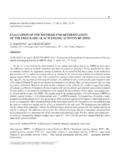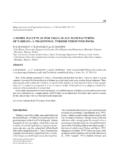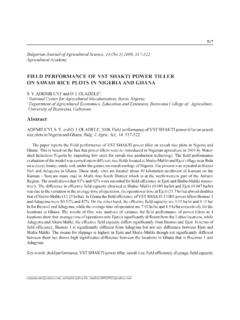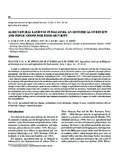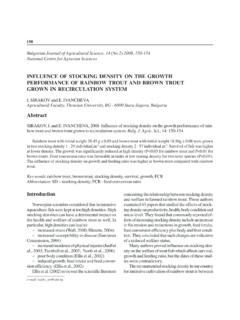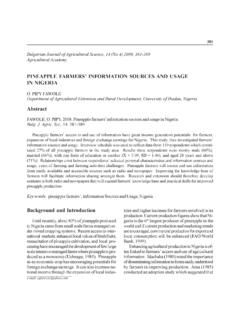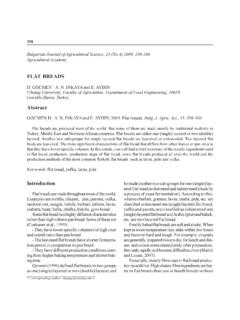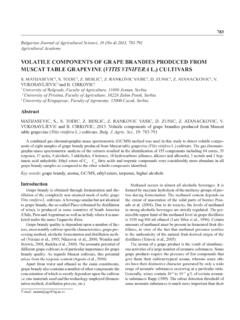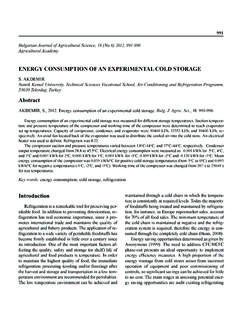Transcription of STUDIES ON LIPASE FERMENTATION USING …
1 290. Bulgarian Journal of Agricultural Science, 14 (No 3) 2008, 290-299. Agricultural Academy STUDIES ON LIPASE FERMENTATION USING candida . CYLINDRACEA NRRL Y-17506IN A STIRED TANK BIOREACTOR. A. KRASTANOV1, A. GOVINDARAJAN2 and D. DANIEL2. 1. University of Food Technologies, Department of Biotechnology, BG - 4002 Plovdiv, Bulgaria 2. Chemical Engineering Division, VIT University, Vellore-632014, Tamil Nadu, India Abstract KRASTANOV, A., A. GOVINDARAJAN and D. DANIEL, 2008. STUDIES on LIPASE FERMENTATION USING candida cylindracea NRRL Y-17506 in a stired tank bioreactor. Bulg. J. Agric. Sci., 14: 290-299. LIPASE is an enzyme of considerable commercial and industrial importance. The major applications of LIPASE are in the fat and oleochemical, food and dairy, textile, detergent, cosmetics, tea processing, pulp and paper, and leather industries. The present work deals with the production of LIPASE by candida cylindracea NRRL Y-17506. and focuses on the effects of aeration, agitation and dissolved oxygen on LIPASE production by submerged fermen- tation USING candida cylindracea NRRL Y-17506.
2 The analysis showed that enhanced LIPASE production can be achieved with 200 rpm, vvm and 100% dissolved oxygen concentration. Laboratory scale FERMENTATION with candida cylindracea NRRL Y-17506 at the different process conditions was performed to study the changes in cell morphology. There was a considerable difference in the morphology of the culture in the bioreactor when compared to that in the shake flask. Formation of pseudo hyphae was initiated in the 24th hour simultaneously with vacuolation, after which the cells formed clumps that grew larger. The presence of agitation led to the aggregation of cells with vacuolation which in turn decreased the enzyme production. On the other hand, when the vacuoles were separated the production of enzyme increased. It is evident that with increase in agitation the production of LIPASE and the cell growth decreased. Aeration also was found to affect the LIPASE production significantly. Key words: LIPASE , candida cylindracea, submerged FERMENTATION , cell morphology Introduction catalytic activities available, the high yields possible, ease of genetic manipulation, regular supply due to lipases (EC ) also known as triacylglycerol absence of seasonal fluctuations and rapid growth of hydrolases are hydrolytic enzymes, which catalyze the microorganisms on inexpensive media.
3 lipases from hydrolysis of the ester linkage of long chain a large number of bacterial, fungal, plant and animal acylglycerols at the oil-water interface. Microbial en- sources have been purified to homogeneity (Saxena zymes are often more useful than enzymes derived et al., 2003). lipases isolated from different sources from plants or animals because of the great variety of have a wide range of properties depending on their STUDIES on LIPASE FERMENTATION USING candida cylindracea NRRL Y-17506in a Stired Tank Bioreactor 291. sources with respect to positional specificity, fatty acid stirring rate (300 rpm). Their investigations revealed specificity, thermo stability and pH optimum (Huang, that different bioreactors can lead to similar enzyme 1984). activity yields provided the microorganism was al- The first commercially successful enzyme, LIPASE lowed to grow under similar conditions with regards was introduced by Novo Nordisk in 1988 under the to drop size. Sokolovska et al.
4 (1998) investigated trade name Lipolase , which originated from the fun- the influence of aeration, substrate type and concen- gus Humicola lanuginosa. In 1995 two bacterial li- tration on production of extracellular LIPASE by Can- pases were introduced Lumafast from Pseudo- dida cylindracea in a batch bioreactor. Both olive oil monas mendocina and Lipomax from Pseudo- and oleic acid when used as the carbon sources gave mnas alcaligens, both produced by Genencor Inter- almost identical activity and the production of extra- national. Currently, iindustrial enzymes are manufac- cellular LIPASE was growth associated. They found that tured by three major suppliers: Novozymes, Denmark, maintaining the oxygen concentration at the recom- Genencor International Inc., US and DSM NV, Neth- mended value for optimum LIPASE production required erlands. LIPASE are marketed by various brand names the enrichment of air flow by pure oxygen. like Lipopan, Lipozyme, Novozyme, Patalase, Grea- Gulati et al.
5 (2000) studied the FERMENTATION be- sex, Lipolase and Lipoprime. havior of Aspergillus terreus in a 10 litre fermentor. lipases of microbial origin have gained consider- The LIPASE activity in shake flask was 7000 U/l in 96 h able attention in the field of biotechnology and a large wheras it was enhanced to 14200 U/l in 54 h in the number of microbial strains have been used for the fermentor. USING controlled inoculum density, dis- enzyme production. Ciafardini et al. (2006) studied solved oxygen levels and agitation higher LIPASE yields LIPASE production by candida rugosa in universal were obtained both in terms of production and purifi- yeast medium. They found that maximum enzyme cation methodology adopted. Elibol and Ozer (2001). activity was obtained when the medium was supple- studied the effect of oxygen on LIPASE production by mented with urea, maltose and olive oil. Sarkar et al. Rhizopus arrhizus under two operating modes, con- (1998) studied the production and optimization of trolling dissolved oxygen and controlled aeration rate.
6 Microbial LIPASE USING Pseudomonas sp. Their tests They found that the oxygen transfer rate determined with different organic and inorganic nitrogen sources the cell growth and LIPASE production rather than the revealed that organic nitrogen source except glycine dissolved oxygen concentration. He and Tan (2006). exhibited inhibitory effect on LIPASE production. determined the optimal growth conditions for LIPASE Fadiloglu and Erkmen (2001) reviewed the effects of production by candida cylindracea under different carbon and nitrogen sources on LIPASE production by agitation speeds and aeration in a fermentor. Maxi- candida rugosa. An enzyme activity U/ml was mum lipolytic activity was observed when the micro- obtained with yeast extract and protease-peptone in organisms were at the beginning of the stationary the medium supplemented with olive oil. However, growth phase. Yang et al. (2005) studied the produc- with tryptone and lactose minimum activity of U/ tion of LIPASE by immobilization of Rhizopus arrhizus ml was observed.
7 Olive oil as the carbon source in in submerged FERMENTATION with control of agitation, presence of nitrogen sources promoted growth and airflow rate and temperature. LIPASE activity was LIPASE activity. Their results showed the ability of Can- U/ml in batch FERMENTATION where as in repeated batch dida rugosa to grow and produce LIPASE from indus- FERMENTATION it was found to be U/ml. trial by-products. Alonoso et al. (2005) reported the improvement Dalmau et al. (1997) studied the influence of the of LIPASE production at different stirring speeds and drop size of oleic acid on extracellular LIPASE produc- oxygen levels. Higher stirring speeds resulted in me- tion by candida rugosa. LIPASE production was chanical and/or oxidative stress, while lower stirring found to increase with increasing drop size at a low speed seems to limit oxygen level. The highest LIPASE 292 A. Krastanov, A. Govindarajan and D. Daniel activity was obtained at 200 rpm and vvm. They erature has focused in selection of carbon and nitro- found that a stirring speed of 100 rpm appeared to gen sources and their optimization for the enzyme pro- limit oxygen levels, impairing culture medium homog- duction.
8 Information on simultaneous influence of pro- enization and reducing lipid availability or uptake by cess parameters like aeration, agitation and dissolved the cells. Li et al. (2005) investigated the production oxygen on LIPASE production in bioreactors and their of LIPASE by Acinetobacter radioresistens with re- effects on cell morphology is scarce. Hence, in the peated fed batch culture USING Tween 80 as a carbon present project an attempt has been made to study source. They found higher LIPASE production rate with the effect of these parameters on LIPASE production in Tween 80 as the carbon source and proposed a re- laboratory scale bioreactor USING candida peated fed-batch culture with DO-stat feeding as the cylindracea NRRL Y-17506 and determine the ef- mode for LIPASE FERMENTATION . fect of process parameters with enzyme production Puthli et al. (2006) studied the FERMENTATION kinet- and morphology of the cells. ics for the synthesis of LIPASE by candida rugosa in a batch system USING triple impellor bioreactor at an Materials and Methods operating speed of 600 rpm and at different aeration rates.
9 A high dissolved oxygen concentration was found Microorganism to be responsible for the decreased LIPASE produc- candida cylindracea NRRL Y-17506 a strain tion. The cell mass increased by 20% and LIPASE ac- that produce LIPASE was used throughout this study. tivity improved by folds as compared to shake The organism provided by Department of Agri- flask STUDIES . They also established that protease en- culture, Illinois as a gift. The organism was maintained zyme released in the medium towards the end of the on MYGP slants at 4 C and subcultured regularly exponential phase of the cell growth did not signifi- every 15 days. cantly affect the LIPASE activity. He and Tan (2006). used response surface methodology to optimize the Media culture medium for the production of LIPASE with Can- The organism was grown in MYGP and potato dida sp. 99-125. The LIPASE yield increased to 6230 dextrose medium. The MYGP medium contained the IU/ml and 9600 IU/ml in shake flask system and 5l following ingredients per litre: peptone - 5 g; dex- fermentor respectively.
10 Trose - 10 g; yeast extract - 3 g and malt extract - 3 g. Falony et al. (2006) reported the production of The potato dextrose medium consisted of 2 g dex- LIPASE in Aspergillus niger USING both submerged fer- trose in 100 ml potato infusion. The initial pH of both mentation and solid-state FERMENTATION . Moderate the medium was adjusted to , prior to autoclaving enzyme activity was obtained in solid-state fermenta- (120 o C for 20min). tion USING wheat bran which appeared to be the high- est among those reported in literature concerning fun- Inoculum development and shake flask gal sources. Noor et al. (2006) studied the effect of cultivation carbon and nitrogen sources on the LIPASE activity by Cells from the slants were scrapped off and sus- candida cylindracea DSMZ 2031 in a seven litre pended in 10 ml of sterile water. The suspension was batch bioreactor. They used palm oil, palmitic acid, then shaken thoroughly to break up any aggregates. lauric acid, olive oil and cooking oil as carbon source.
